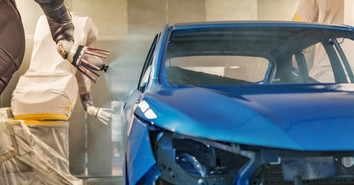When the automobile first hit the streets, it revolutionized transportation. However, it didn’t take long for people to decide that they needed to differentiate their vehicles by customizing the look and feel of their rides.
Over the years, automotive paint has evolved from simple protective coatings to a complex blend of art and science that enhances both vehicle aesthetics and performance. Explore this brief history of automotive paint and coatings to understand their importance from the past to the present.
Early 1900s: The Dawn of Automotive Paint
In the early days of the automobile, paint served a purely utilitarian purpose. Its primary role was to protect metal surfaces from corrosion and rust. Black was the predominant color due to its quick-drying properties, making it perfect for the assembly lines of the time.
However, as cars became more than just a mode of transport, the demand for aesthetic appeal grew. By the 1920s, color options expanded, reflecting societal shifts toward personal expression and style. The introduction of new pigments and varnishes marked the beginning of automotive paints moving beyond mere function.
1930s to 1950s: Color Innovation and the Rise of Lacquer
With color’s growing importance in automotive marketing, the 1930s saw significant advancements in paint technology. The introduction of nitrocellulose lacquer allowed for a broader palette and smoother finishes. These lacquers dried quickly and could be polished to a high gloss, providing a luxurious sheen.
During the 1940s, metallic finishes started to gain popularity. World War II had a surprising impact on this trend, as surplus aluminum from warplanes was used to create shimmering, eye-catching effects on cars. The 1950s further pushed the envelope with the development of acrylic lacquers. These offered better UV resistance and retained their glossy finish longer than their predecessors.
1960s to 1980s: Acrylic Enamels and Polyester Coatings
The 1960s ushered in more durable acrylic enamels. These paints were more resistant to the elements and maintained their luster over time. Technological enhancements during this period significantly improved the longevity and resilience of automotive finishes.
By the 1970s, polyester coatings emerged, providing even more durability. These coatings were applied in layers, with a clear coat over the base color for protection and added gloss. This era also witnessed a shift away from traditional solvent-based options.
1990s to Present: High Tech Coatings and Environmental Advancements
The late 20th century marked a pivotal point in the evolution of automotive paint. With growing environmental concerns, the industry turned to waterborne coatings, which reduced volatile organic compounds (VOCs) emissions. These environmentally friendly paints have since become the standard in many regions.
Additionally, the use of advanced polymers and compounds has taken paint performance to new heights. Modern automotive coatings offer enhanced scratch resistance, UV protection, and self-healing properties. The incorporation of smart pigments that change color with temperature or light intensity demonstrates the cutting edge of automotive innovation.
Take Advantage of Advanced Paint Protection
From their humble beginnings to today, the history of automotive paint and coatings is still taking shape. For business professionals and auto enthusiasts alike, understanding the potential of automotive paint provides valuable insights into the industry.
Whether you’re a seasoned automotive expert or a curious newcomer, exploring the world of automotive paint and coatings allows you to appreciate the art and science behind every finish. At DuraCoat, our industrial paint finishes have been influenced by the rich history and innovations of the industry. Contact our team today to learn how our products can keep your vehicle in pristine condition.

